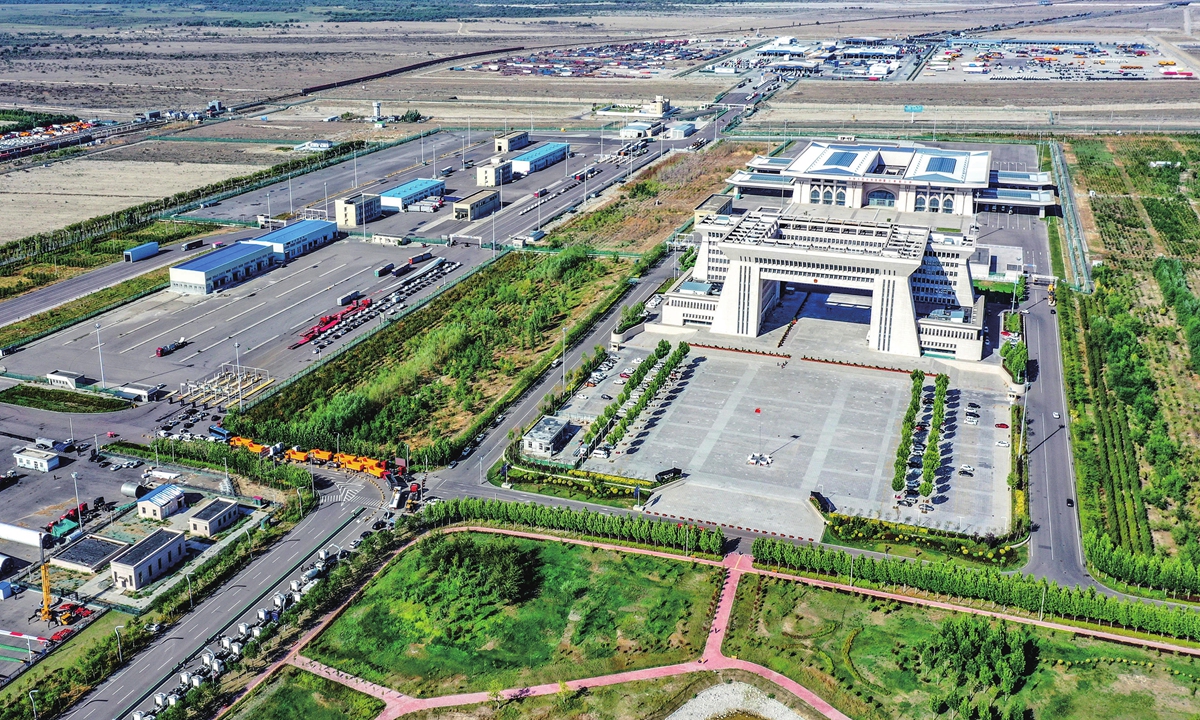

A view of the Khorgas International Border Cooperation Center on the China-Kazakhstan border Photo: VCG
Editor's Note: Recently, the signing of the trilateral government agreement on the China-Kyrgyzstan-Uzbekistan railway project has attracted widespread international attention. Once constructed, this railway line will effectively improve freight transportation efficiency, connecting China, Central Asia, and even Europe more closely and facilitating deeper integration, leading to continuous mutual benefit and win-win results. Djoomart Otorbaev, the former prime minister of Kyrgyzstan, shared his perspective on the significance of this flagship project amid the progress of Eurasian transportation.
Two transformative projects, recently unveiled, are on the horizon. They are ready to revolutionize the transport infrastructure of the China-Europe route, with a specific focus on strengthening the Middle Corridor.
President of Kyrgyzstan, Sadyr Japarov, signed the law on Thursday to ratify the intergovernmental agreement for the joint construction of the China-Kyrgyzstan-Uzbekistan Railway. The agreement had been ratified by the Parliament of the Kyrgyz Republic on June 19. This transformative project, signed on June 6 in Beijing, is not just a railway but a monumental game-changer for Eurasian transportation and economy, heralding a new era of connectivity and trade.
The plan involves the construction of 18 railway stations, 81 bridges with a total length of 26.1 kilometers (km), and 41 tunnels with a total length of 120.39 km. In other words, the total length of bridges and tunnels will be 146.49 km or 47 percent of the length of the entire section of Kyrgyzstan. The railway will pass at altitudes above 3,000 meters in some sections, showcasing the ambitious project's immense scale and intricacy.
However, there is no doubt about the successful execution of this project, as demonstrated by a similar project recently carried out by Chinese companies involving the construction of high-mountain railways between Kunming, Southwest China's Yunnan Province and Vientiane in Laos.
It is planned that 7 to 15 million tons of cargo will be transported annually along this railway. It was announced that the parties had adopted a road map indicating specific time frames for implementing the project. Construction will begin in October and will be a meticulously planned process lasting about six years.
Members of the Kyrgyz Parliament were informed that construction is planned under the BOT (build-operate-transfer) arrangement through the creation of a joint project company (JPC) in which China Railway International will own 51 percent, and the national railway operators Kyrgyz Temir Zholu and Uzbekistan Temir Yollari will own of 24.5 percent apiece. The estimated construction cost in Kyrgyz territory is $4.7 billion. It is projected that half of this amount - $2.35 billion - will be provided to JPC by the Chinese side as a loan. The remaining amount will need to be invested by the parties in proportion to their shares in the JPC's capital. At the hearing, it was announced that the terms and interest rate of the loan provided by China would be determined at a later stage.
Another large-scale project opening significant prospects for East-West multimodal transport is starting in the South Caucasus. In late May, the Georgian authorities announced the results of a contest to select an investor for building the deep-sea port of Anaklia on the Black Sea. The country's Minister of Economy and Sustainable Development, Levan Davitashvili, revealed that the China Communications Construction Company (CCCC) emerged as the winner.
Prime Minister Irakli Kobakhidze commended the selection, highlighting the extensive experience of the Chinese company in similar projects. He commented on the volume of investment and the potential of the new port:
"The estimated investment volume of the first phase will be $600 million, and after completion of this stage, the port will be able to receive 600,000 containers. It has a cargo handling capacity of 7.8 million tons." Construction is expected to take place in nine phases with a total investment of at least $2.5 billion. Once constructed, the port of Anaklia will be capable of accommodating sizeable ocean-going container ships with a capacity currently unavailable in Georgia.
The ongoing surge in rail freight between China and Europe drives the economic viability of both.
For example, on May 25, the 90,000th freight rail flight between China and Europe was completed. Since trade commenced on this route in 2011, over 8.7 million twenty-foot equivalent unit (TEU) containers have been transported, carrying cargo valued at more than $380 billion. Now, these freight trains connect 223 cities in 25 European countries and over 100 cities in 11 Asian countries.
The construction of this railway line will create the shortest land route between Asia and Europe. Simultaneously, it will establish direct rail links between China and Central Asia, the South Caucasus, Iran, Turkey, and Europe for the first time.
The new railway lines will intersect in Central Asia with planned and under-construction north-south railway lines from Russia and Central Asia, passing through Afghanistan, Pakistan, Azerbaijan, and Iran to reach the deep-sea ports of the Indian Ocean. Once fully implemented, the plan could transform Central Asia into a unique transport hub for the entire Eurasian continent.
To all of the above, it should be added that the European Union recently announced the allocation of 10 billion euros to co-finance the Middle Corridor's infrastructure. Thus, all the countries along this route not only support the transport project but also allocate significant financial resources for the prompt commencement of construction.
Given the intense interest in developing the China-Europe transport corridor through Central Asia and the South Caucasus, with all necessary financial and technological resources available from participating countries, there are significant opportunities for accelerated development. Accordingly, it is essential to coordinate the efforts of all related partners to optimize planning and commence construction as soon as possible.
The author is the former prime minister of Kyrgyzstan, a distinguished professor of the Belt and Road School of Beijing Normal University, and the author of the recent book Central Asia's Economic Rebirth in the Shadow of the New Great Game. bizopinion@globaltimes.com.cn





